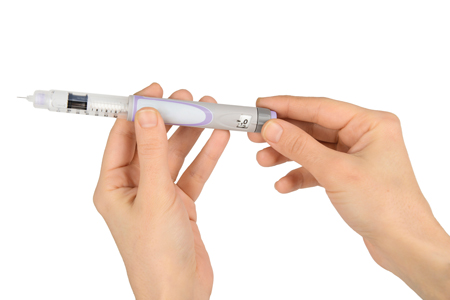AIDC is a Sign of Things to Come: Part II Combo Products Can Benefit Most from Serialization

In order to save overall payer costs, ensure access to products when needed and improve compliance with protocols, combination products are often designed to be administered by patients or nonprofessional caregivers.
This moves combination products into relatively untrained and unregulated hands. Oral dosage is rather simple. Injection, inhalation and other parenteral dosages, however, are more complex, and because they require special handling, these often fragile and costly combination products are designated “specialty products.” In spite of their challenges, these products provide the greatest hopes for improved patient outcomes. Specialty products represent the majority of products currently moving through the U.S. FDA approval process.
Many of these specialty products require injections which can create potential biohazards demanding some level of product control before, during and after use. These facts make informing and gathering information from users ever more important.
This all comes back to serialization. In Part I (“AIDC is a Sign of Things to Come: Part I,” November/December 2017), I covered how serialization allows stakeholders better ways to gather information about a product. Combination products represent a segment of the industry that could benefit most from serialization, in my opinion.
When it comes to the information embedded within a product’s serialized code, there is a wealth of information that can be stored and referenced in databases. Certain manufacturing changes may not normally occasion a lot or batch number change. This is especially important for combination products since they have more mechanical and electronic components from an array of suppliers than simpler dosage forms. More components and more vendors can result in failure to report potentially meaningful changes.
Experience has shown that the use of thousands of dose administrations in field conditions may be necessary to really learn product performance. There are many changes that can occur in component manufacture and in the field. Examples include mold repair issues, component processing, changes in resin lots, vendor, software or firmware changes and other changes thought by a vendor to be innocuous. Also, the combination product itself may change while in patient hands. Information about abuse, loss, damage, residual shelf and battery life can be important.
We all know that consumer appliances often include an insert detailing minor product changes made to a model. This complicates instructions. Neither retail consumers, nor patients or other stakeholders follow printed instructions anyway. All are very unlikely to sort through model numbers. Printed information is fixed. When it comes to combination products, these facts together make serialization essential differentiated from consumer appliances. Serialization allows information to be sent to individual stakeholders about their specific combination product, facilitating product-specific communication and reducing confusion.
Reducing confusion about your combination product is more important than confusion about your dishwasher.
Fortunately, many—even most—patients already have a tool, i.e., their smartphones, to capture serial numbers. Patients can also monitor and provide information on use and nonuse, and information from companion products, such as diagnostic devices, personal health monitoring devices, etc. In addition, patients can submit personal observations. They might even provide information about products from competitors.
Combo Products Meet the Real World
Combination product failures are sometimes obvious to users. Patients, caregivers and other stakeholders now inform each other via social media about their real-world experiences. Facebook posts and Tweets are becoming part of realworld evidence (RWE) or real-world data (RWD). More regulators and payers now demand RWE/D.
The National Evaluation System for health Technologies (NEST) incorporates initiatives to mine social media as RWE. On Aug. 31, FDA issued Use of Real-World Evidence to Support Regulatory Decision-Making for Medical Devices for comment (1). The FDA’s stated intent is to “collect the needed data to address the public health questions.”
Competitors and litigators also mine the Internet, including social media. An important question is: Who will have the data first and who is best able to interpret and use the information? Arguably, the answer is the combination pharmaceutical product marketer.
How much credence RWE/D will assume in both prospective (approval) and retrospective (post-market) situations is still unclear. There is a lot to learn from adherence and behavioral data, but it can be difficult to collect meaningful day-to-day statistics.
The challenges of combination product approval and reimbursement are already complicated. If RWE/D simply becomes yet another gate to get through on the way to drug approval, it will seriously hamper digital health innovation.
The combination product industry stakeholder community is fragmented. No one company has all the resources required to do everything. Therefore, pharma needs to be able to collect and analyze information related to causes, effects and perceptions of their products from other stakeholders (e.g., patients, payers, distributors, pharmacies, regulators, prescribers, programmers, device suppliers and device component suppliers). Knowledge of real-world product performance and patient outcomes is essential.
Medication telemanagement enabled by serialization presents opportunities to provide better care and to avoid risks. Product management, including adherence and compliance, is essential to safety and efficacy.
Human factors issues compound combination product challenges. Product instructions might be poorly provided, misunderstood, forgotten or ignored. The use of combination products by untrained, unlicensed individuals with varying levels of education, mechanical ability and language facility opens questions of what human factors will come to bear on use. It is not possible to have algorithms built into systems covering every possible situation. Concerns about human factors often delay product launch. The very real win with serialization is the ability to respond to the effects of human factors that arise in the real world.
Serialization can enable information to assist in intelligent responses. If pharma has access to necessary information close to real time, this can be used to better help end users manage their products. Just as Apple’s Geniuses (Apple’s trademark) help customers understand and use Apple products (most of which are serialized and have cataloged experiential data to allow assisted intelligence), pharma can enhance product value by providing expert service. Satisfying service is now often provided by mediated communication (e.g., prompting a patient to find a serial number before the Genius engages) and assisted intelligence (using known prior experience with a specific patient or serialized product to assist a “Genius” in finding the answer for a patient’s current question).
Serialization allows pharma to make situational changes to protocols for a group of products, a class of users or even a specific user. Some examples are immediate product corrective actions, refresher training in the protocol and techniques and rotating administration sites.
For combination products, a revised version of the GS-1 Q&A about UDI serialization for all products in Part I may be instructive. The italicized content below is added to this section in the companion article.
How much control of my products in the supply chain should I have when the supply chain extends to patient self-use and involves patient human factors?
How expensive are my products? Does tracking the products afford me better control of these expensive assets? Combination products are often quite expensive.
How much risk can we assume if something goes wrong? With lot/batch, I will have one level of risk; with serialization, I will have significantly less risk since I will be able to bound the issue in smaller groups and not an entire batch/lot. The number of contractors and components involved in combination products and the possibilities for patient misuse multiply the risks.
How do I want to handle a recall? With lot/batch, how many products will be impacted vs. serialization controls where a company can be bound by serial number? These issues should be considered in light of the human factors and contractor/component complexities.
Can serialization help me avoid recalls, postmarketing costs and reputational damage?
Many stakeholders lay claim to “owning” the patient relationship; pharma needs to be able to access and correlate certain information to serve its role in the drug/patient relationship. Pharma can be well served by having access to information enabled through serialization and then applying their expertise in cooperation with other stakeholders for the benefit of patients, as well as their own and others’ interests. Serialization helps achieve these benefits.
Please consider these words from Bill Gates: “Your most unhappy customers are your greatest source of learning.” Remember that even if you are not learning about your combination product performance, others are. It is better to know your situation than be blindsided by information in the hands of third parties. And, as always, ignorance is a poor defense.
This article contains opinions and is not regulatory guidance. The author and his clients have interests in the use of AIDC in healthcare.
Refernce
- Use of Real-World Evidence to Support Regulatory Decision-Making for Medical Devices, U.S. Food and Drug Administration, Aug. 31, 2017. tinyurl.com/y7kwxwln



